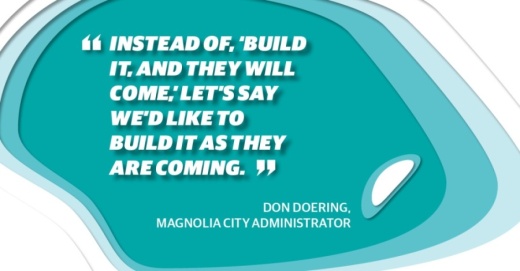“We’re looking at how to serve the future capacity in the most economical and most effective way of servicing—that’s why we’re considering additional plans,” Magnolia City Administrator Don Doering said.
According to Kelly Hajek—project administrator with Strand Associates, the city’s engineering consultant—the firm is now proposing the city add further expansions to its existing wastewater treatment plant on Nichols Sawmill Road, which would cost less than $10 million and take less than a year to design with construction completed in 15 to 18 months.
“One of the options we’re considering is to further expand the existing plant site, which would be more cost effective for right now and also a faster option and provide more flexibility,” Hajek said.
However, Hajek said the Texas Commission on Environmental Quality regulates how large the existing plant can grow, although specifics on those limitations are yet to be determined.
“The amount of land that the city has available at that site limits how big that plant can get to,” Hajek said.
The construction of a future wastewater treatment plant on Mill Creek Road—an estimated $38 million project requiring an 18-month design period and 2 years of construction—was first presented to council in April, Community Impact Newspaper previously reported, with council members holding off on approving a schedule for water and wastewater development plans in May due to the uncertainty of the COVID-19 pandemic.
Hajek said a new wastewater treatment plant project would provide wastewater services to Magnolia’s east side of town, where development is expected to take place.
“Rather than having to build more lift stations to pump [water] to the Nichols Sawmill [Road] plant, there would be a plant on that side of town,” Hajek said.
City council's Dec. 8 meeting agenda includes taking possible action on an item to move forward with the wastewater treatment plan expansion plan following a presentation by Strand Associates Inc.
Current expansions
Although the city is considering further expansions to its wastewater facility, the city’s existing treatment facility, located at 30910 Nichols Sawmill Road, has been under construction since fall 2019 to expand capacity from 650,000 gallons per day to 1.3 million. The $9.97 million expansion is expected to be completed in spring 2021.
In addition to the wastewater expansion, the city is also undergoing a three-phase project to extend sewer lines from Nichols Sawmill Road to FM 1488, which also began in fall 2019. The project will cost the city just under $4 million and is expected to be completed by late spring to early summer of 2021.
“Now, we’re trying to figure out what we need to do in the future because a lot of the planned growth is Audubon [Magnolia], which is to the east of us,” Doering said.
Audubon Magnolia is expected to bring nearly 5,000 homes beginning in early 2021 near Mill Creek along with commercial development, developer Sam Yager III said during a Greater Magnolia Parkway Chamber of Commerce luncheon in November.
Despite these current projects, Hajek said the city can expect to outgrow its wastewater capacity relatively quickly.
“The city is already working on an expansion of [its] existing plant [on Nichols Sawmill Road] that will be completed this spring, ... but they will have too many new [service] connections for even that expansion in the next two years or so,” Hajek said. “They need to either expand that plan further or construct another wastewater treatment plant on Mill Creek [Road].”
Doering said funding sources for the expansion would come through certificates of obligations paid for through impact fees and service charges. Doering said current tax and wastewater rates are likely to remain unaffected, as the main costs will come from the expected incoming developers and residents.
“Basically as the people move in, they will need more services, and they will be paying for it,” Doering said. “Instead of, ‘Build it, and they will come,’ let’s say we’d like to build it as they are coming.”





